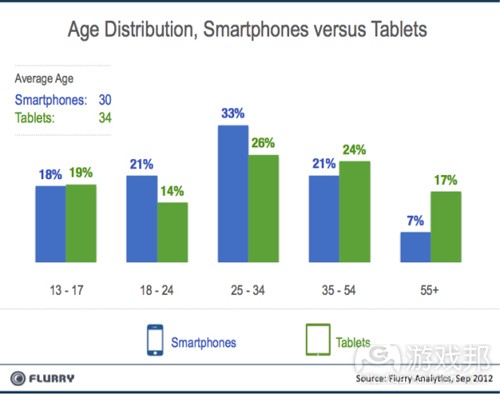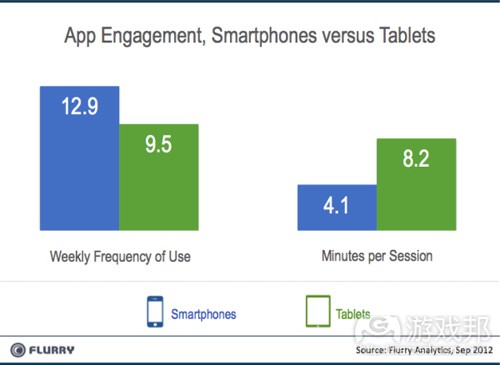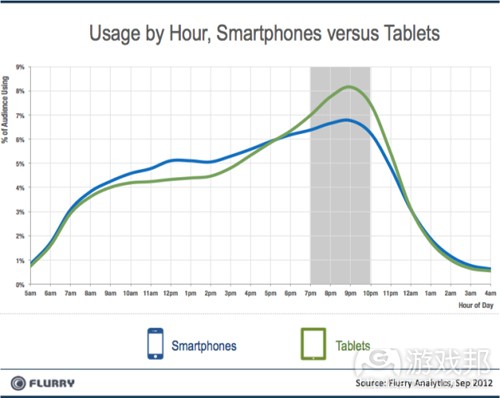每日观察:关注智能手机及平板电脑用户粘性(10.30)
1)IDC最近报告预测,使用移动设备上网的美国用户将从目前的1.74亿增长至2016年的2.65亿,与此同时,使用PC上网的用户则将从现在的2.4亿降至2.25亿。
美国将成为引领这一潮流的市场,西欧和日本则将落后美国两年左右。在2015年,使用移动网络的美国用户将超过使用PC上网的用户。
IDC还指出用户的PC在线活动将有所下降,使用PC访问Facebook等社交网络的用户比例将从2012年的66%降至2016年的52%;预计到2016年国际移动广告收益将从目前的60亿美元增长近5倍左右,达到288亿美元。
2)据gamasutra报道,谷歌最近发布其最新产品Nexus 4智能手机,更新版Nexus 7(3G)以及10英寸的Nexus 10平板电脑;这三款设备均运行最新版Android操作系统Jelly Bean 4.2。
Nexus 10由三星生产,拥有目前平板电脑的最高分辨率,即300ppi 2560 X 1600屏幕(超过了iPad的2048 X 1536 Retina屏幕),仅支持Wi-Fi网络,拥有前后置摄像头,2GB RAM以及1.7 GH的双核Exynos处理器。其中16GB设备售价为399美元,32GB售价为499美元,比iPad售价低100美元。
而更新版Nexus 7技术规格并未改变,不过引进了更高的存储容量并添加了3G支持,降低其售价以便同亚马逊及苹果同类产品相竞争。目前仅支持Wi-Fi的Nexus 7售价为199美元(16GB)和299美元(32GB)。而仅支持Wi-Fi网络的iPad Mini目前售价为329美元,兼容LTE网络的iPad Mini(32GB)设备售价高达559美元。
3)据pocketgamer报道,触控科技最近数据显赫,《捕鱼达人》自2011年来下载量已超过1.2亿次,在中国市场月收益已达1000万人民币(160万美元),《捕鱼达人2》曾在9月份的中国手机热销游戏榜单登顶,收益达260万人民币(约42万美元)。该公司所有游戏在9月份中国手机游戏市场收益中占比4.5%。
该公司目前已进军海外市场,最近发布的《疯狂攀岩家》曾有两周时间位居美国付费榜单前50名。
4)据insidemobileapps报道,动视暴雪日前宣布将推出两款新手机游戏《Skylanders Lost Islands》和《Skylanders Battlegrounds》(游戏邦注:该公司之前已向iOS平台发布《Skylanders Cloud Patrol》),前者是一款免费增值资源管理游戏,而后者则是付费版RPG游戏,拥有堪比掌机游戏的出精致画面。
除此之外,动视暴雪还推出其手机社交游戏平台Activate,支持玩家登陆游戏并使用Facebook认证信息访问好友列表,或者直接创建一个Activate帐号,并允许用户通过云存储服务保存游戏进度,但该公司目前尚未公布这一平台的具体上线时间。
5)Flurry最新数据显示,尽管人们的智能手机和平板电脑用途不同,但总体来看,较年长的用户更常使用平板电脑,他们通常在晚上长时间使用平板电脑体验娱乐和媒体内容(游戏邦注:Flurry报告数据采自9月份的5亿部智能设备)。
从13-34岁年龄段用户来看,平板电脑用户比例均低于智能手机用户,但从35岁用户群体开始,平板电脑用户比例就超过了智能手机用户,在55岁以上群体平板电脑用户比例甚至达到17%,而该年龄段智能手机用户比例仅为7%。报告指出,智能手机用户平均年龄为30岁,平板电脑用户平衡年龄则是34岁。
在智能手机用户中,男女比例分别为56:44,而平板电脑男女比例则是51:49。
用户在智能手机上访问社交网络的投入时间占比24%,玩游戏时间占比39%;平板电脑用户玩游戏投入时间占比高达67%,访问社交网络时间占比仅为10%。
从应用的用户粘性上看,智能手机用户平均每周访问应用频率为12.9次,平板电脑用户则是9.5次;前者平均每分钟访问应用4.1分钟,而后者则是8.2分钟。
从设备使用高峰期来看,多数用户是在晚上7-10点这一时段频繁使用平板电脑与智能手机。
6)跨平台应用商店Mobango最近发布信息图表显示,多数移动用户在乎网络安全问题,56%用户并不信任移动广告,但却有56%用户乐意为移动设备下载内容(其调查对象为来自英国、美国、意大利和印度的800名移动用户,其中智能手机用户占比75%)。
有40%受访者优先使用Wi-Fi作为连网途径,56%智能手机用户更偏爱Wi-Fi连网方式。
总体来看,智能手机用户在移动网络上的投入时间比功能性手机用户多20%;西方国家的女性用户在移动网络上投入时间更高,而印度用户在移动网络上投入时间则高于西方国家用户,35%以上印度用户表示自己更喜欢通过应用来获取信息。
平均来看,智能手机用户的设备上所安装就用比功能性手机用户多50%,智能手机用户平均安装16款应用,而功能性手机用户平均仅安装10款应用。
印度用户平均每月下载应用数量较多,但用户粘性却相对较低,而西方用户却正好相反。
56%用户信任自己所下载的移动内容(44%表示不信任),但同时也有56%用户不相信移动广告(44%相信移动广告)。
(本文为游戏邦/gamerboom.com编译,拒绝任何不保留版权的转载,如需转载请联系:游戏邦)
1)Mobile web use to pass PC-based internet access by 2016
by Daniel Gumble
Set to hit 265m from the current 174m.
The number of consumers using mobile devices as their primary gateway to the internet continues to increase, with many making the move away from PC-based internet usage, IDC has reported.
Leading the trend is the US, with Western Europe and Japan following at around two years behind. It is thought that the number of people using PCs to access the web will fall from 240 million in 2012 to 225 million in 2016, while the number of mobile users will rise from 174 million to 265 million.
This means that in 2015 there will be more US consumers accessing the Internet through mobile devices instead of PCs for the first time ever.
Karsten Weide, programme VP of media & entertainment at IDC, said: “In the consumer world, mobile internet usage is already beginning to displace PC usage, and the United States is leading this trend.
“There has been much talk about how the future of the internet will be mobile first and PC second. In the United States, that future is now.”
The IDC report has also found that online PC activities will decrease, with the number of people using social networks such as Facebook on their PCs dropping from 66 per cent in 2012 to 52 per cent in 2016. Furthermore, the report suggests that international mobile advertising will almost quintuple from $6 billion to $28.8 billion in 2016.
Meanwhile, worldwide business-to-consumer (B2C) m-commerce spending looks set to grow six fold between 2011 and 2016, reaching $223 billion at the end of the forecast period.
“The Great PC Exodus on the Internet is happening because the PC was never truly a consumer product,” added Weide. “Many consumers use them because there was no better alternative. Now, with the huge and growing installed base of more user-friendly tablets and smartphones, there are.”(source:mobile-ent)
2)Google unveils new Nexus devices, Android 4.2 OS
Kathleen De Vere
Google has expanded its Nexus line adding a Nexus 4 smartphone, a revamped version of the Nexus 7 tablet with options for 3G data, and a new 10 inch tablet dubbed the Nexus 10.
Unveiled today via blog post, all three devices run the latest version of Android, Jelly Bean 4.2. The new version of the mobile operating system adds gesture typing controls, improved dictionaries and text-to-speech capabilities, support for multiple user profiles, wireless display sharing with an HDMI wireless display adaptor, expanded, actionable notifications and improvements to Google Now. Google has also introduced something it calls the Photo Sphere camera — its own answer to iOS 6’s panorama mode.
On the tablet side of things, the brand-new Samsung-built Nexus 10 has the highest resolution of any tablet currently available. The device comes witha 300ppi 2560 x 1600 display, larger the iPad’s 2048 x 1536 Retina display. The Wi-Fi only device comes with front and rear cameras, 2 GB of RAM and a 1.7 GH dual core Exynos processor. The 16 GB model will cost $399 and the 32 GB model will cost $499, making the Nexus 10 a full $100 cheaper than the comparable models of iPad.
While the Nexus 7’s technical specs remain unchanged, Google has introduced new models with higher storage capacity and added the option for 3G data. Google has also lowered the price on the Nexus 7 line to make it even more competitive against Amazon’s and Apple’s offerings. The Wi-Fi only Nexus 7 now costs $199 for a 16 GB device and $249 for a 32 GB device. An HSPA+ 3G enabled device with 32 GB of storage capacity will cost $299. By comparison, the standard 16 GB Wi-Fi only iPad Mini is priced at $329, and a comparable 32 GB LTE iPad Mini will cost $559.
Finally, the new Nexus 4 smartphone comes with a 4.7” screen with 320 PPI display and 1280 x 768 resolution. The device also has a 1.5 GHz Snapdragon S4 processor, 2 GB of RAM, an 8 MP rear-facing camera and is available with either 8 or 16 GB of storage. The phone has both NFC and Bluetooth, but does not support LTE internet. Prices range from $199 for a 16GB device with a two year contract to $349 for a fully unlocked 16 GB device.
The Nexus 4 smartphone and the Nexus 10 tablet will be available for purchase through the Google Play store on November 13. The new versions of the Nexus 7 tablets are shipping now.(source:insidemobileapps)
3)Fishing Joy franchise is generating $1.6 million a month in China
by Jon Jordan
Companies such as NaturalMotion and Supercell have revealed the sort of revenue you can generate from a top grossing game in the US and Europe.
But what about in China?
We can get an idea how that market is developing from publisher Punchbox. It’s released figures from its very popular Fishing Joy franchise of games.
Since 2011, they have been downloaded more than 120 million times, with monthly revenue from China in the region of 10 million RMB (around $1.6 million).
Reel them in
And the games are still performing well.
Fishing Joy 2 was the top grossing game for China Mobile during September 2012; generating 2.6 million RMB (around $420,000).
Indeed, across all its games, Chukong (the parent company of Punchbox) accounted for 4.5 percent of China Mobile’s games revenue during September.
The company is now looking to find success outside of China, most recently releasing Pocket Climber, which was in the US top 50 paid chart for two weeks. (source:pocketgamer)
4)Activision Blizzard unveils two new mobile Skylanders titles, Activate mobile-social platform
Scott Reyburn
Video game giant Activision Blizzard unveiled today two new mobile Skylanders games and Activision Blizzard’s mobile-social platform Activate.
Skylanders Lost Islands and Skylanders Battlegrounds will join previously released Skylanders Cloud Patrol on iOS devices this fall. Lost Islands is a free-to-play resource management game in the same vein as DragonVale and The Simpsons: Tapped Out, but Lost Islands focuses less on managing a locale and more on building up the Skylanders characters. Skylanders Battlegrounds is a premium RPG game that’s running the same graphics engine as recently released Skylanders Giants in an effort to bring a console-like experience to mobile.
Alongside announcing two new Skylanders mobile titles, Activision Blizzard is throwing their hat in the mobile-social platform ring with Activate, joining competitors such as DeNA’s Mobage and Gree’s OpenFeint. Activate is a social platform that allows users to login into a mobile game with Facebook credentials for access to their friends list or create an account with Activate. For the two upcoming Skylanders games, Activate for example, allows for cloud storage meaning users can access their game state on any iOS device at any time. Activision Blizzard plans to roll out Activate to previously released games and all new ones going forward. A release date has not been set for the platform.(source:insidemobileapps)
5)Tablet or smartphone? It might depend on your age (charts)
By Ryan Kim
While tablets are shrinking and smartphones are just getting bigger, people are still using them in very different ways. Flurry has some new data to show just how the two devices diverge and how their users compare. And it generally comes down to this: tablets appeal to an older and more gender-balanced audience, who like to use their tablets for entertainment and media, preferably over long sessions at night.
Some of this has already been reported, but it’s interesting to see how the differences remain, even as tablets sales accelerate and smartphone adoption has passed the 50 percent mark in the U.S. The data, which was pulled from 500 million smart devices in use during September, show how tablets and smartphones serve different use cases and needs.
I found it interesting that tablet usage is pretty evenly balanced among men and women. We’ve reported last year that women have gravitated more to e-readers while men have adopted tablets, but it seems like tablets are now common ground for both genders. It’s also interesting to note just how much game-playing happens on tablets, which makes sense because as we’ve noted mobile games are most often played at home, where the tablet is most often used. (source:gigaom)
6)INFOGRAPHIC: 56 per cent of mobile users don’t trust mobile ads
by Zen Terrelonge
Despite that, 56 per cent are happy to put their faith in downloading mobile content.
Cross-platform app store Mobango has conducted a survey with mobile users in the UK, US, Italy and India to determine how they feel about the mobile web.
Most mobile users tend to have security fears and the infographic shows that 56 per cent of users don’t trust mobile ads, yet 56 per cent are happy to download content to their devices.
Meanwhile, India shows a higher consumption of the mobile web compared to western countries.(source:mobile-ent)

















































 闽公网安备35020302001549号
闽公网安备35020302001549号